Research on Temperature Control of Mass Concrete for Multi-Tower Cable-Stayed Bridge Cap during Construction
Abstract
:1. Introduction
2. Engineering Overview
3. Design of Temperature Control Scheme for Mass Concrete Cap
3.1. Raw Materials and Concrete Mix Ratio
3.2. Layered Pouring Method and Cooling Water Pipe Arrangement
3.3. Maintenance Measures
4. Numerical Simulation Analysis
4.1. Calculation Theory and Principle
4.2. Calculation Parameters and Boundary Conditions
4.3. Analysis of Calculation Results
4.3.1. Temperature Calculation Result
4.3.2. Stress Calculation Results
5. Temperature Monitoring during Cap Construction
5.1. Temperature Control Standards
5.2. Temperature Control Monitoring Program
5.2.1. Temperature Detection Contents and Measuring Instruments
5.2.2. Temperature Monitoring of Pile Cap Construction Process
5.3. Analysis of the Detection Results
6. Discussion
7. Conclusions
Author Contributions
Funding
Data Availability Statement
Conflicts of Interest
Abbreviations
| Symbol | Description |
| thermal diffusivity | |
| c | heating capacity |
| T | temperature function |
| k | exothermic coefficient |
| temperature difference | |
| Q0 | final hydration heat of cement |
| F | the amount of mixed materials |
| W | the amount of cement |
| the insulating layer thickness | |
| u | water velocity |
| the inner and the outer diameters of the water pipe | |
| density | |
| time | |
| adiabatic temperature rise | |
| thermal conductivity | |
| heat release coefficient | |
| γ | regulation factor |
| the diameter ratio of inside and outside cooling water pipe |
References
- Truman, K.Z.; Petruska, D.J.; Norman, C.D. Creep, shrinkage, and thermal effects on mass concrete structure. J. Eng. Mech. 1991, 117, 1274–1288. [Google Scholar] [CrossRef]
- Nilimaa, J.; Hösthagen, A.; Emborg, M. Thermal crack risk of concrete structures: Evaluation of theoretical models for tunnels and bridges. Nord. Concr. Res. 2017, 56, 55–69. [Google Scholar]
- Nassiraei, H.; Yara, A. Static Strength of Tubular K-Joints Reinforced with Outer Plates under Axial Loads at Ambient and Fire Conditions. Metals 2023, 13, 1857. [Google Scholar] [CrossRef]
- Tajima, K.; Moriizumi, K.; Shirai, N. Numerical calculation mechanics model considering hydration of concrete. In Proceedings of the Fourth International Conference of Fracture Mechanics of Concrete and Concrete Structures, Cachan, France, 28 May–1 June 2001; pp. 107–114. [Google Scholar]
- Wilson, E.L. Determination of Temperatures within Mass Concrete Structures; Structural Engineering, University of California San Diego: San Diego, CA, USA, 1968. [Google Scholar]
- Wang, J.; Wei, G.; Liu, J.; Chen, J.; Zuo, Y. Measurement and analysis of hydration heat in massive concrete pile cap of a sea-crossing bridge. Bridg. Constr. 2020, 50, 25–31. [Google Scholar]
- Wen, D.; Zhang, X.; Chen, G. Temperature control and numerical analysis for massive concrete cushion cap of Hai-huang bridge. J. Wuhan Univ. Technol. 2019, 41, 78–83. [Google Scholar]
- Liu, S.; Yin, Z. Study on temperature control and crack resistance of mass concrete anchorage in suspension bridge. Vibroeng. Procedia. 2021, 38, 124–128. [Google Scholar] [CrossRef]
- Mardmomen, S.; Chen, H.-L. Prediction of the early age thermal behavior of mass concrete containing SCMs using ANSYS. J. Therm. Anal. Calorim. 2023, 148, 7899–7917. [Google Scholar] [CrossRef]
- Qin, F.; Fan, F.; Li, Z.; Qian, H.; Jin, X. Thermal simulation of hydration heat in slab of taishan nuclear power plant unit 2. Comput. Civ. Build. Eng. 2014, 1214–1221. [Google Scholar] [CrossRef]
- Zhang, Z.; Wang, K.; Li, Y.-L.; Zhang, W.-M. Study of influential factors of hydration heat and surface cracking resistance of concrete pier in construction. Bridg. Constr. 2015, 45, 65–70. [Google Scholar]
- Zou, P.; Chang, H.-J.; Wang, F.; Cai, Y.-L.; Zhang, Z.; Zhao, Z.; Lv, Z.-D. Effect of steam curing scheme on the early-age temperature field of a prefabricated concrete T-beam. Case Stud. Constr. Mater. 2024, 20, e02787. [Google Scholar] [CrossRef]
- He, Y.; He, J.; Yu, P.; Zhang, B.; Fu, X. Study on temperature control of mass concrete for tower pile cap. J. Railw. Sci. Eng. 2020, 17, 372–378. [Google Scholar]
- Wang, Q.; Chen, C.; Hu, Z.; Li, Y.; Wu, J. Engineering measurement and numerical simulation of hydration heat temperature field of mass concrete of beam bearing platform. Concrete 2020, 371, 139–143+147. [Google Scholar]
- Liu, X.; Zhang, C.; Chang, X.; Zhou, W.; Cheng, Y.; Duan, Y. Precise simulation analysis of the thermal field in massconcrete with a pipe water cooling system. Appl. Therm. Eng. 2015, 78, 449–459. [Google Scholar] [CrossRef]
- Zhu, B. Theoretical solution of the temperature field in the construction lift of concrete dam under the simultaneous action of pipe cooling and natural cooling from the lift surface. Water Resour. Hydropower. Eng. 2010, 41, 27–28. [Google Scholar]
- Yang, H.; Liu, J. Study on the hydration heat temperature field of mass concrete. and the application of key construction technologies for a certain cable stayed bridge cap. Highw. Eng. 2018, 43, 152–156. [Google Scholar]
- Lu, Z.; Wang, X. Research on temperature control of mass concrete cushion cap considering water pipe cooling. J. Railw. Sci. Eng. 2015, 12, 1172–1178. [Google Scholar]
- Si, Z.; Wang, S.; Wang, Z.; Xi, L. Simulation analysis of mass concrete pipe cooling based on heat flow coupling algorithm. J. Xi’an Univ. Technol. 2017, 33, 270–275. [Google Scholar]
- Geng, M.; Lin, E.; Lv, J.; Fu, B. Hydration heat analysis and temperature control of mass concrete pile cap. Concrete 2021, 9, 50–55. [Google Scholar]
- Gu, G.; Xu, W.; Wu, Y.; Jia, Y.; Zhou, B. Optimization of temperature control technology for water pipe cooling of mass concrete. Concrete 2021, 11, 141–145. [Google Scholar]
- Zhang, B.; Song, S.; Qian, Y.; Liu, Y. Research on temperature control of mass concrete construction of bridge foundation. J. Liaoning Technol. Univ. 2017, 36, 614–618. [Google Scholar]
- Li, Z.; He, J.; Yu, P. Temperature and stress field monitoring and finite element analysis of mass concrete of cable tower cushion cap. J. Railw. Sci. Eng. 2020, 17, 2892–2900. [Google Scholar]
- Sun, Z.; Tian, J.; Shi, Q.; Liu, W.; Chen, H.; Xu, Q.; Zhang, B. Finite element simulation of inside-outside temperature gradient and thermal stress for abutment mass concrete. J. Traffic. Transp. Eng. 2016, 16, 18–26+36. [Google Scholar]
- Miao, S.; Cong, Q.; Ren, F.; Fang, W. Study on hydration heat simulation of mass concrete based on ANSYS. Sichuan Build. Sci. Res. 2009, 35, 194–197. [Google Scholar]
- Yuan, G.; Huang, F.; Shen, H.; Gao, P. Study on hydration heat temperature field and thermal stress during mass concrete construction. Concrete 2005, 2, 86–88. [Google Scholar]
- Yan, H.; Li, D.; Zhou, H. Hydration heat analysis and crack control of large baseplate. Ind. Archit. 2005, 35, 862–866+871. [Google Scholar]
- Wan, H.; Tan, Z. Anti-crack construction technology of mass concrete for main bridge cap of south dongting super large bridge. J. China Foreign Highw. 2017, 37, 141–144. [Google Scholar]
- Xu, W.; Yan, Z.; Zhang, S.; Liu, J. Technique of controlling temperature field and concrete expansion to limit cracking in pylons of main navigational channel bridge of hutong changjiang river bridge. Bridg. Constr. 2020, 50, 44–49. [Google Scholar]
- Li, J.; Wang, Y. Study on dynamic curing design of pile cap massive concrete of Shanghai-Nantong Yangtze river bridge. Railw. Stand. Des. 2016, 60, 93–99. [Google Scholar]
- Qin, Y.; Zhang, Q.; Yu, Y. Temperature control techniques for massive concrete of intermediate pylon pile cap of pingtang bridge. World Bridg. 2018, 46, 30–34. [Google Scholar]
- Van Tran, M.; Chau, V.N.; Nguyen, P.H. Prediction and control of temperature rise of massive reinforced concrete transfer slab with embedded cooling pipe. Case Stud. Constr. Mater. 2022, 18, e01817. [Google Scholar] [CrossRef]
- Matallah, M.; Taibi, A.; Chimoto, T.; Maradzika, F. Mesoscale investigation of mass concrete temperature control systems and their consequences on concrete mechanical behaviour. Frat. Integrita Strutt. 2022, 16, 416–437. [Google Scholar] [CrossRef]
- Ouyang, J.; Chen, X.; Huangfu, Z.; Lu, C.; Huang, D.; Li, Y. Application of distributed temperature sensing for cracking control of mass concrete. Constr. Build. Mater. 2019, 197, 778–791. [Google Scholar] [CrossRef]
- Singh, P.R.; Rai, D.C. Effect of piped water cooling on thermal stress in mass concrete at early ages. J. Eng. Mech. 2018, 144, 1–11. [Google Scholar] [CrossRef]
- Li, S.-S.; Zheng, J.-Y.; Zhang, F.-J.; Li, H.-M.; Jia, M.-X.; Liu, Z.-J.; Chen, A.-J.; Xie, W. Prediction of shear strength for steel-fiber high-strength concrete corbels with the softened strut-and-tie model. Buildings 2023, 13, 1107. [Google Scholar] [CrossRef]
- Deng, N.; Yu, M.; Yao, X. Intelligent active correction technology and application of tower displacement in arch bridge cable lifting construction. Appl. Sci. 2021, 11, 9808. [Google Scholar] [CrossRef]
- Yue, Z.; Ding, Y.; Zhao, H.; Wang, Z. Case study of deep learning model of temperature-induced deflection of a cable-stayed bridge driven by data knowledge. Symmetry 2021, 13, 2293. [Google Scholar] [CrossRef]
- Zeng, Y.; Zheng, H.; Jiang, Y.; Ran, J.; He, X. Modal analysis of a steel truss girder cable-stayed bridge with single tower and single cable plane. Appl. Sci. 2022, 12, 7627. [Google Scholar] [CrossRef]
- Yao, S.; Peng, B.; Wang, L.; Chen, H. Structural performance and reasonable cross-ratio of cross-cable multi-tower cable-stayed bridges. Building 2022, 12, 764. [Google Scholar] [CrossRef]
- Tawfik, T.A.; Kamal, A.H.; Faried, A.S. Assessment of the properties of concrete containing artificial green geopolymer aggregates by cold bonding pelletization process. Environ. Sci. Pollut. Res. Int. 2024, 31, 27329–27344. [Google Scholar] [CrossRef]
- Li, Y.; Xu, W.; Zhu, J.; Yang, L. Effect of fly ash content on the performance of hardened cement-based materials suffered from high temperatures. Case Stud. Constr. Mater. 2024, 20, e03217. [Google Scholar] [CrossRef]
- Mahmoud, H.A.; Tawfik, T.A.; El-razik, M.M.A.; Faried, A.S. Mechanical and acoustic absorption properties of lightweight fly ash/slag-based geopolymer concrete with various aggregates. Ceram. Int. 2023, 49, 21142–21154. [Google Scholar] [CrossRef]
- Zhu, Z.; Qiang, S.; Chen, W. A new method solving the temperature field of concrete around cooling pipes. Comput. Concr. 2013, 11, 441–462. [Google Scholar] [CrossRef]
- Zhang, H. Construction technology of 3.5m mmass raft concrete for super high-rise tower under high temperature environment. Build. Technol. 2024, 55, 1737–1742. [Google Scholar]
- Wang, H. Research on anti cracking technology of mass concrete for main structure of bangladesh river bottom tunnel project. China’s High-Tech. 2022, 22, 120–122. [Google Scholar]

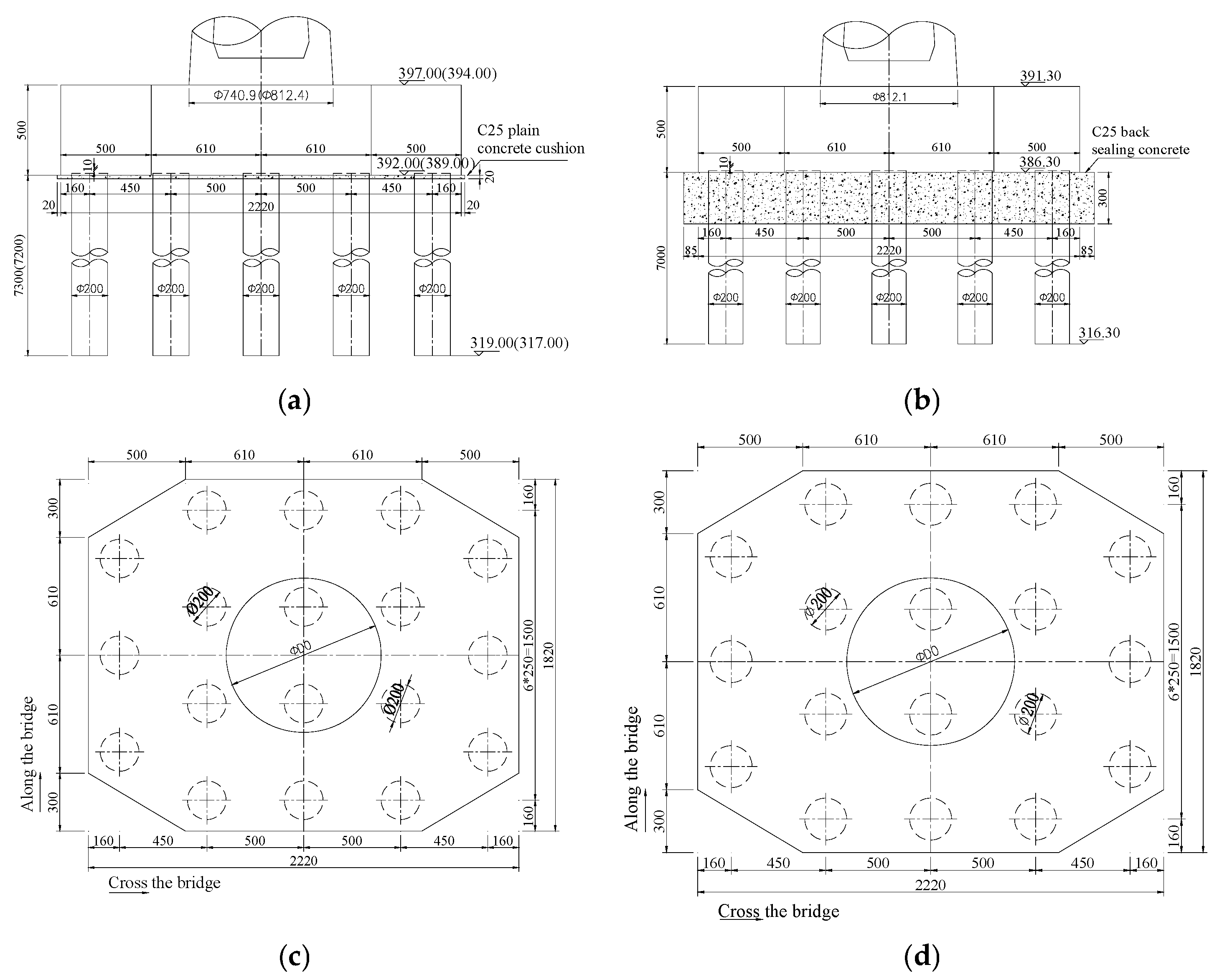
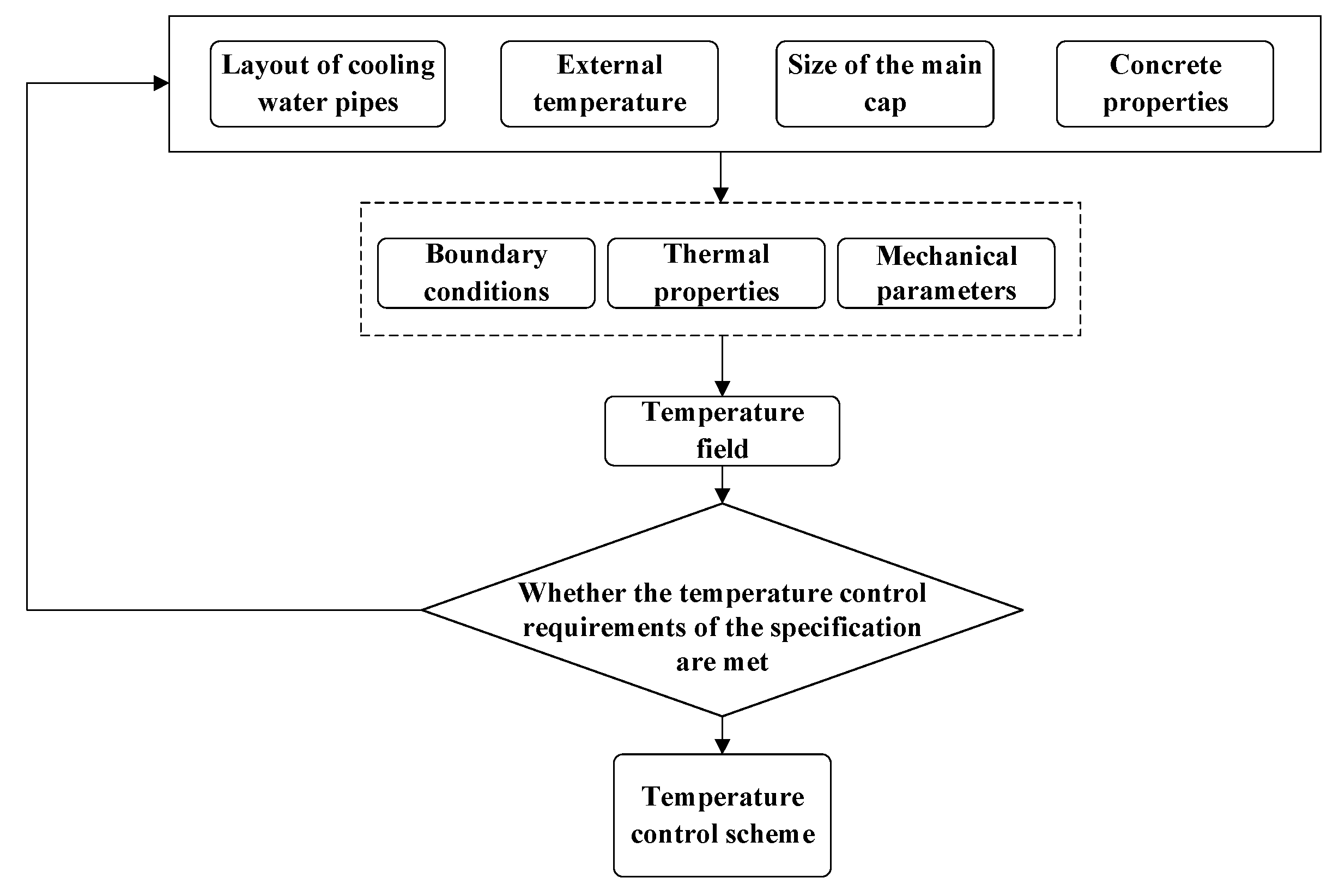
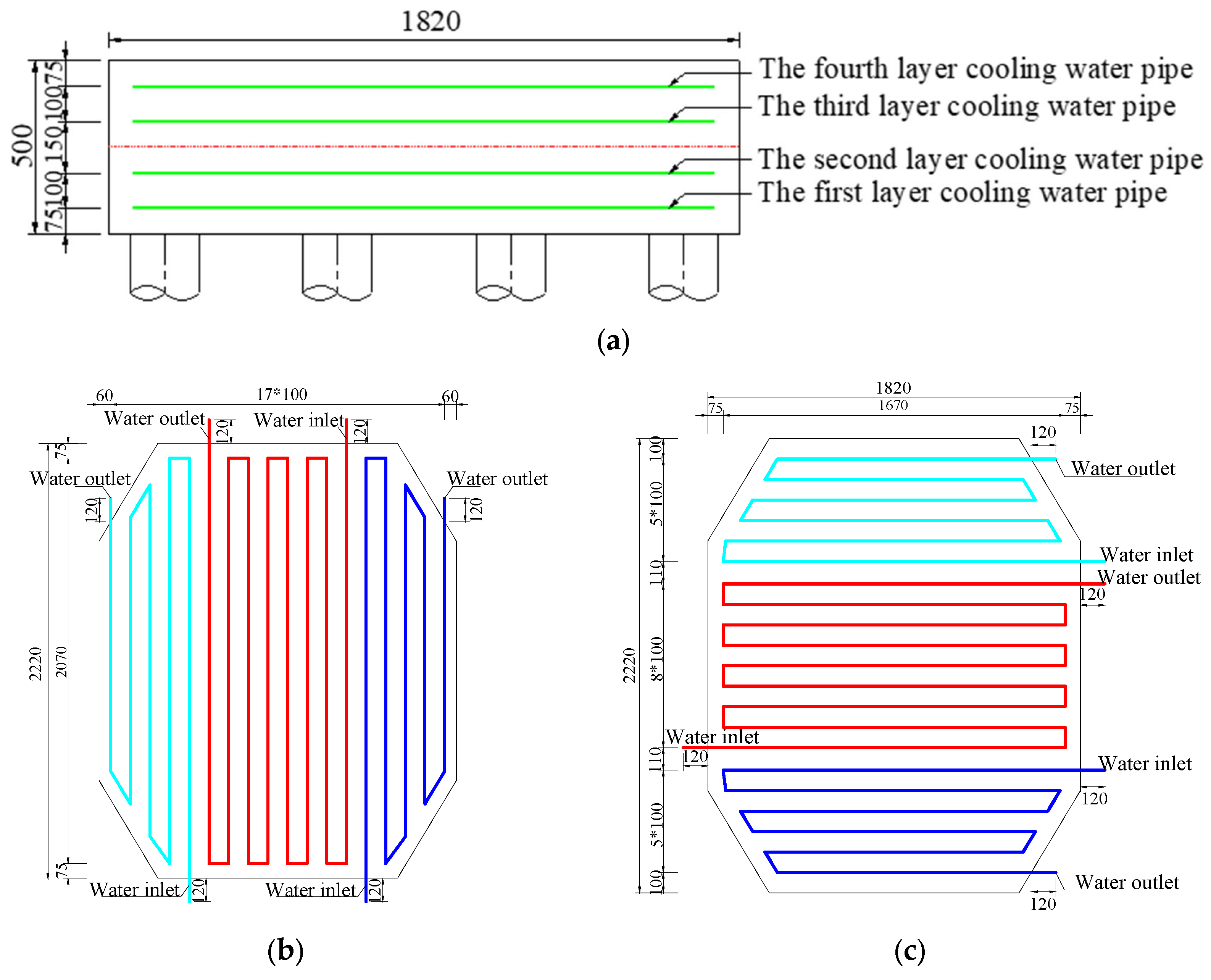


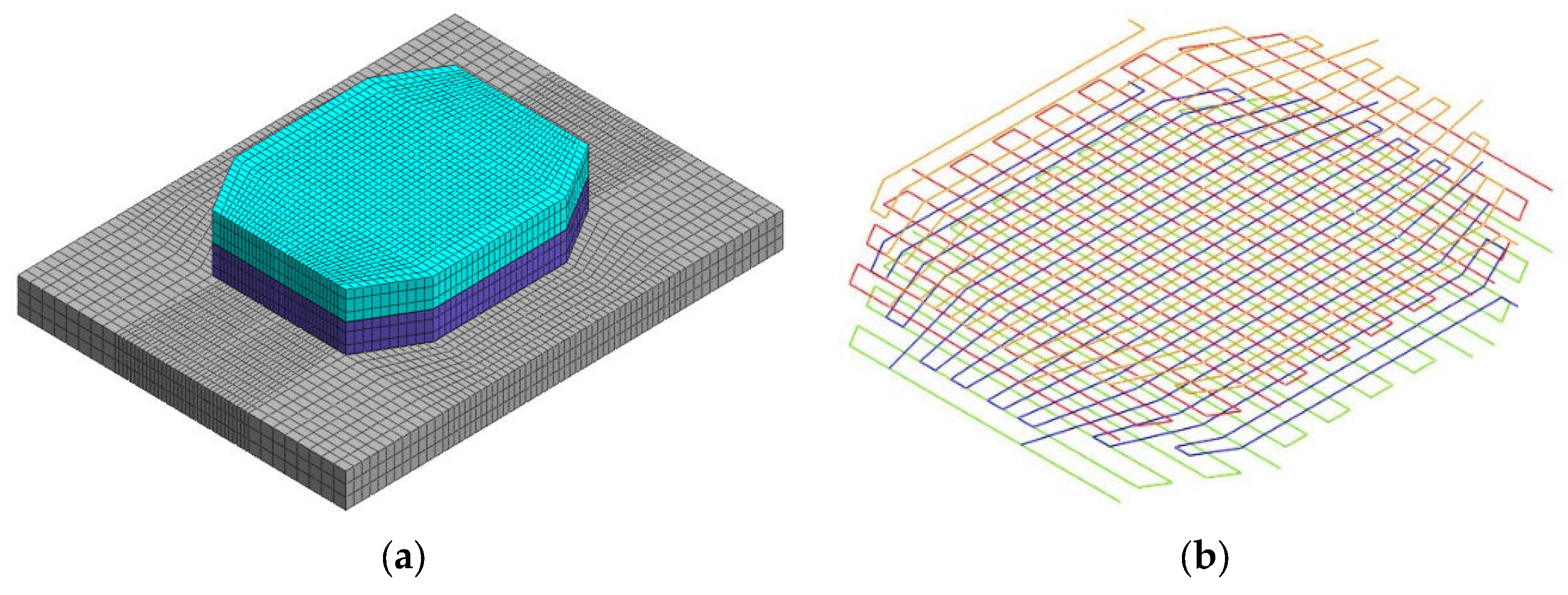
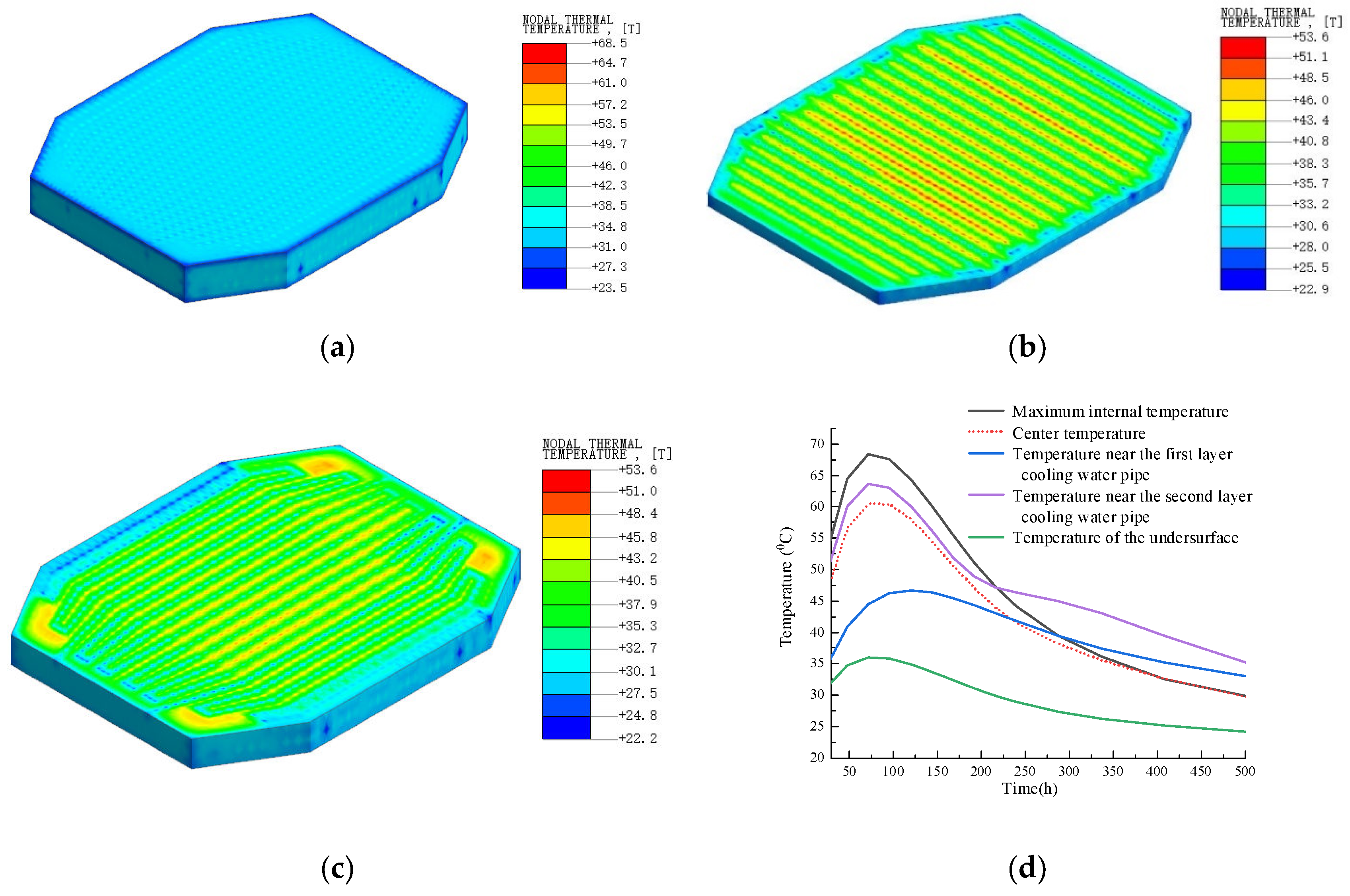


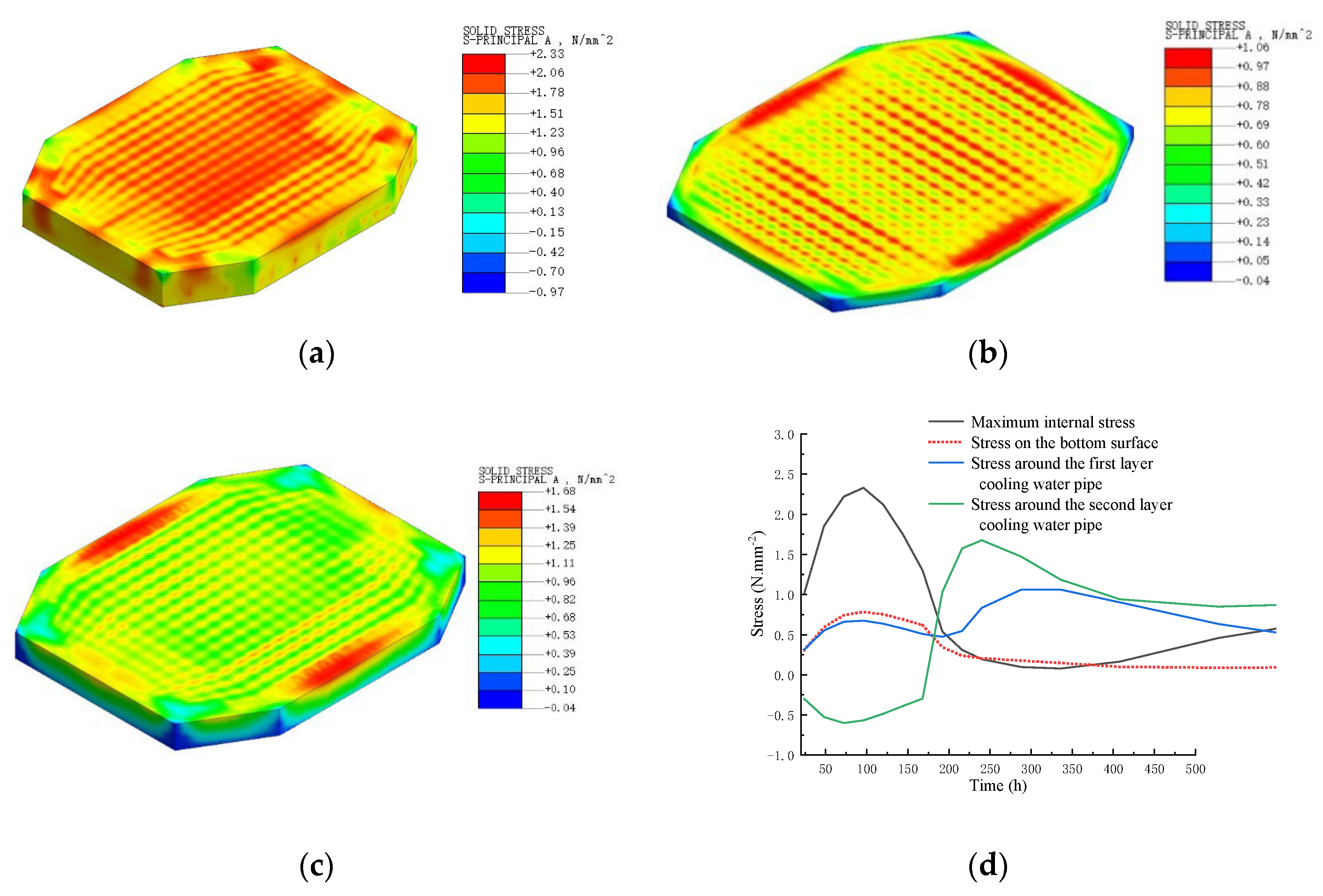



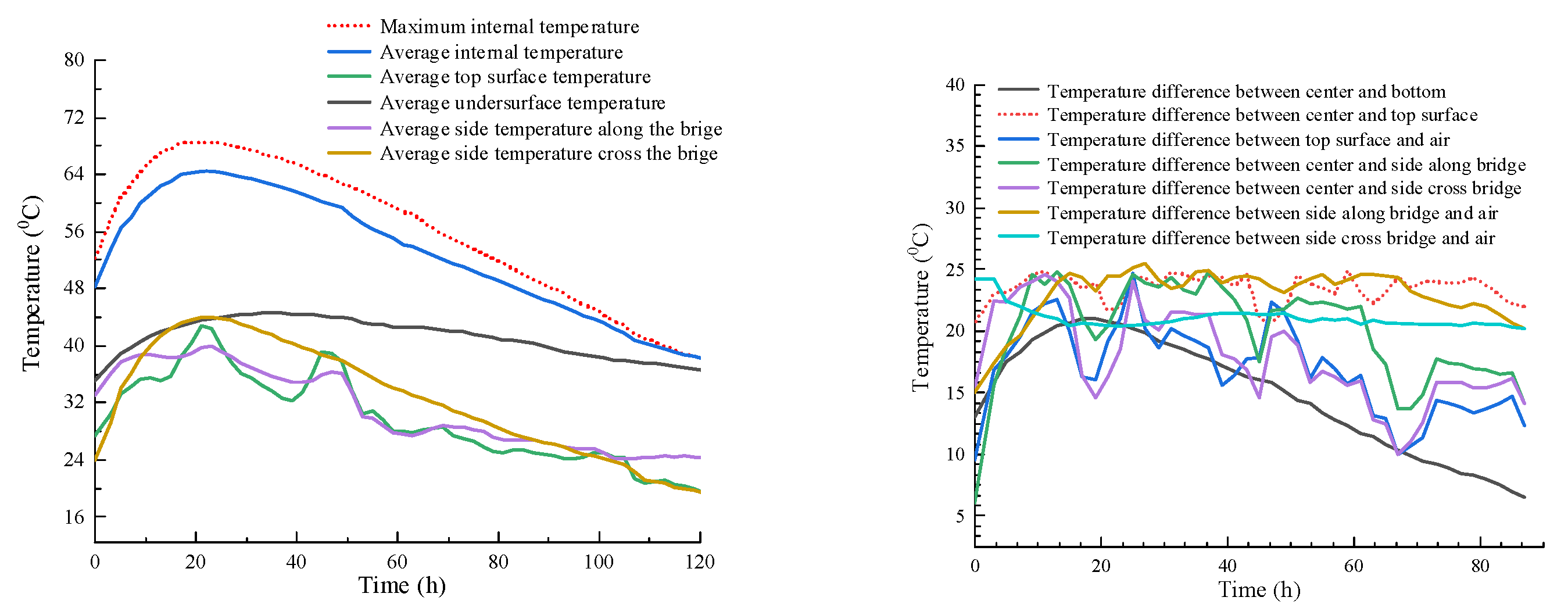
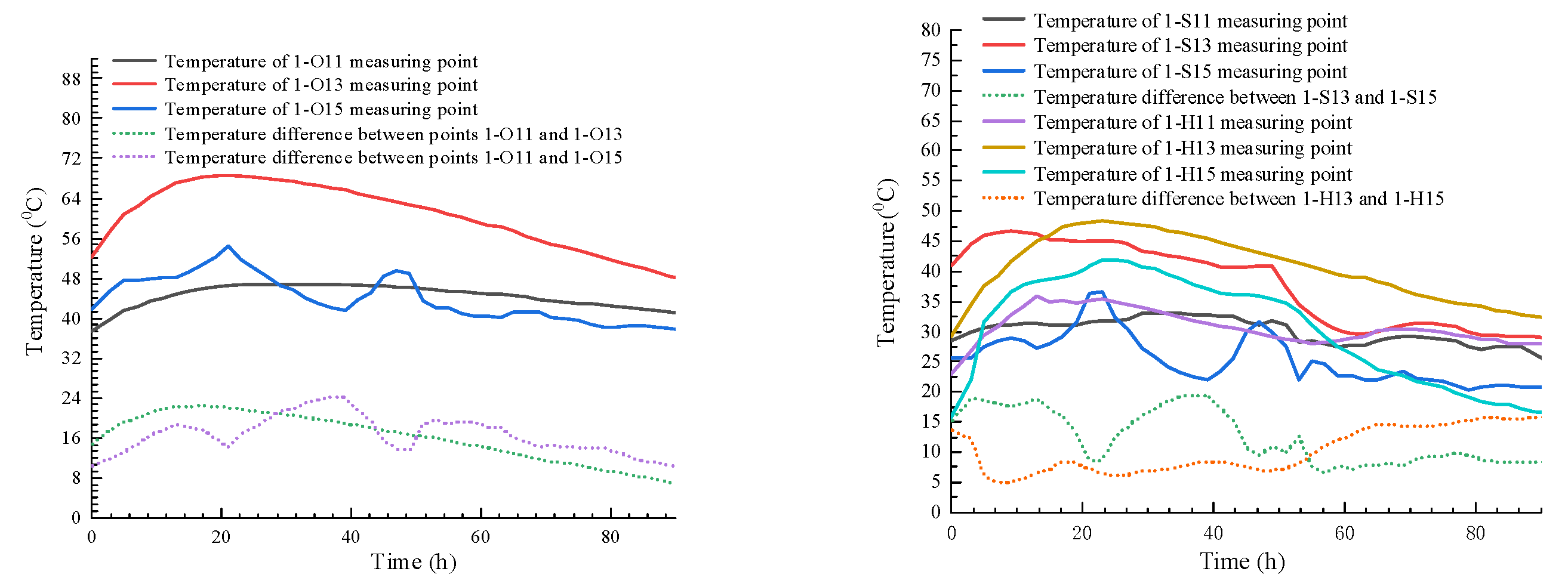
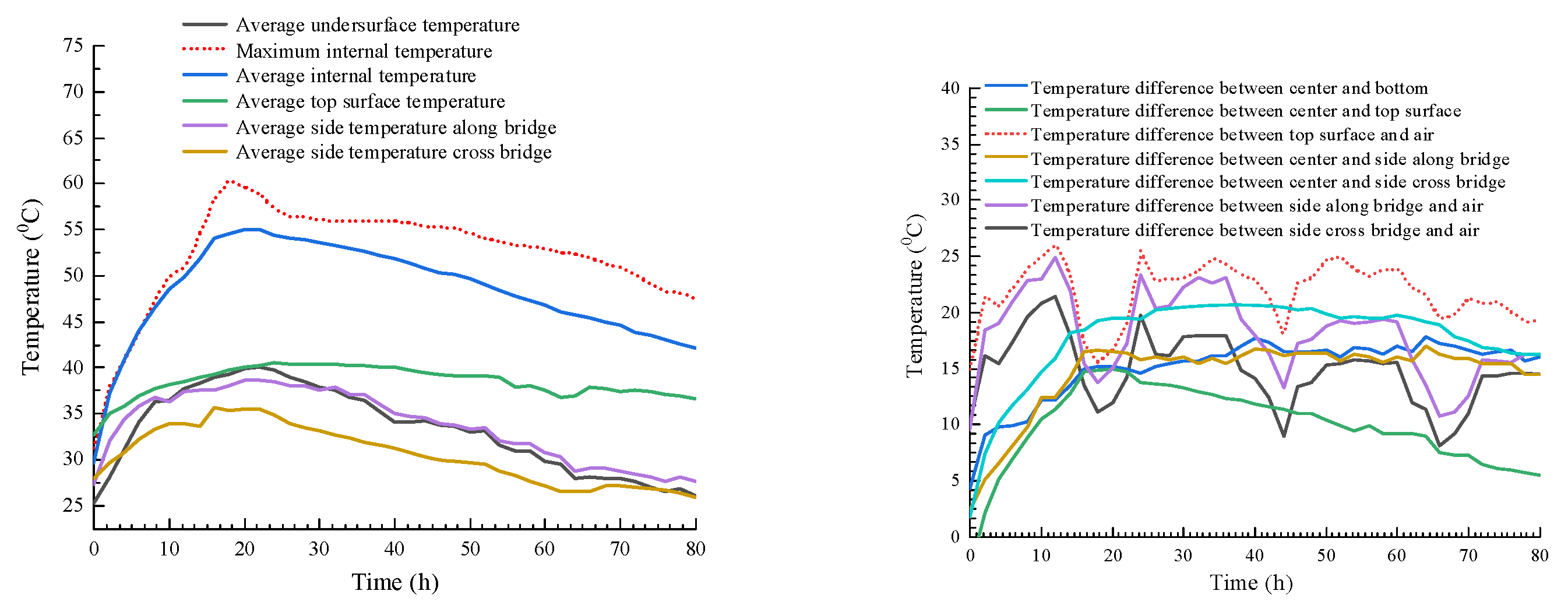

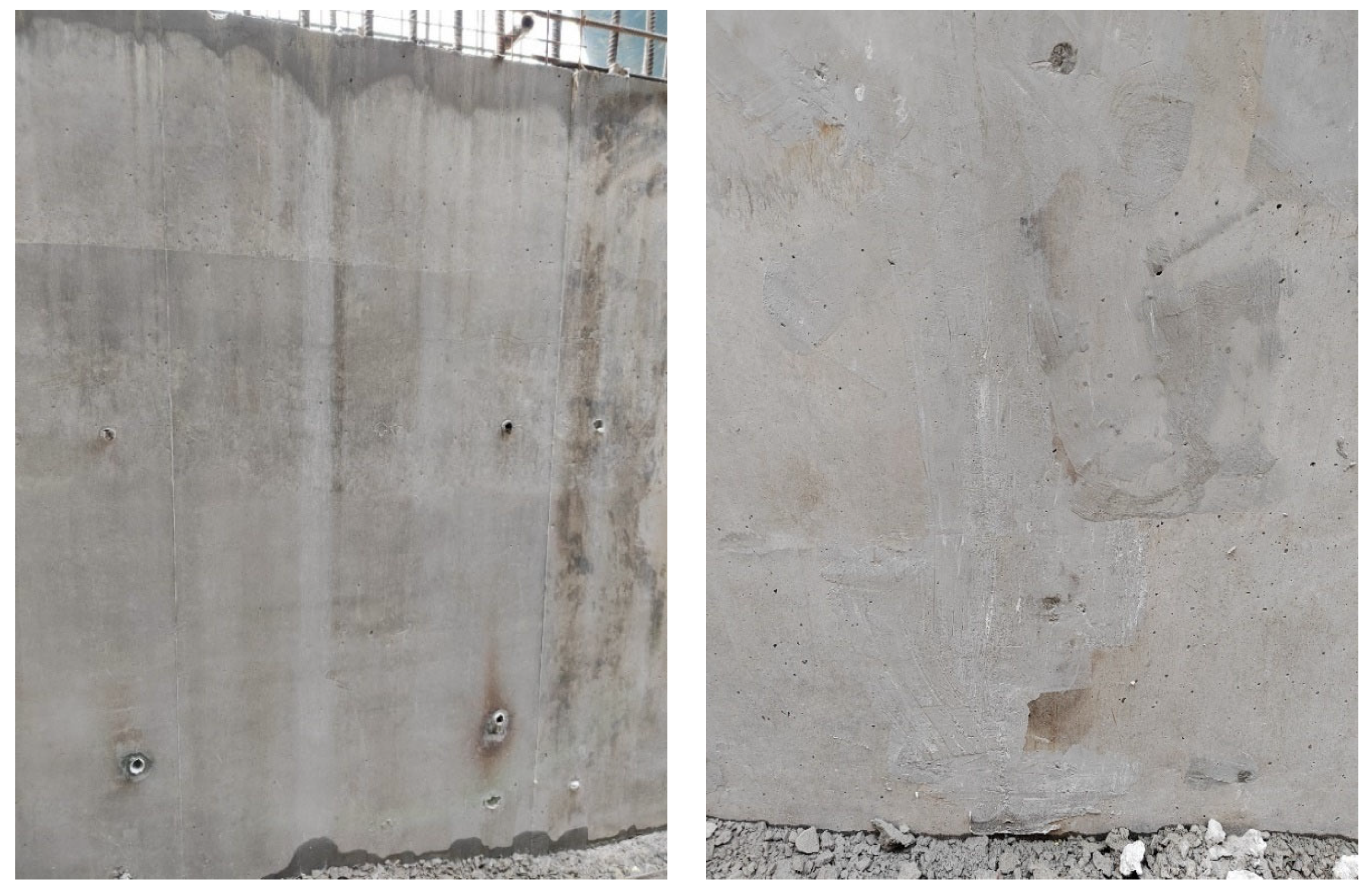
| Project Name | Main Pier Cap of Fengyi Bridge C40 Concrete Mix Design | |||||||
|---|---|---|---|---|---|---|---|---|
| Material name | Type | Technical indicators | ||||||
| Raw materials | Cement | Jidong low-alkali P·O 42.5 Cement | ||||||
| Fly ash | Grade Ι | |||||||
| mineral powder | Ordinary mineral powder | Specific surface 500 m2/kg | ||||||
| Sand | Medium sand | Fineness modulus 2.6~2.8 | ||||||
| Gravel | Continuous grading 5~25 mm | |||||||
| Water-reducing agent | Polycarboxylic acid high-efficiency water-reducing agent | |||||||
| Proportions of C40 concrete mix | (kg/m3) | Cement | Fly ash | Mineral powder | Sand | Gravel | Water | Water-reducing agent |
| 240 | 80 | 90 | 750 | 1070 | 153 | 8.2 | ||
| Mechanical Properties | Concrete |
|---|---|
| Density(kg/m3) | 2390.1 |
| Coefficient of linear expansion (1/T) | 1 × 10−5 |
| Poisson’s ratio | 0.2 |
| Specific heat capacity (kJ/(kg°C)) | 1.0 |
| Pyroconductivity (kJ/(m·h·°C) | 10 |
| Construction season | |
| Average temperature during construction | 23 |
| Temperature of concrete entering mold (°C) | 26 |
| Adiabatic heating (°C) | 42 |
| 7-day tensile strength (MPa) | 2.8 |
| 28-day elastic modulus (N/mm2) | 3.25 × 104 |
| Serial Number | Temperature Control Item | Control Standard | Basis |
|---|---|---|---|
| 1 | Pouring temperature of concrete | ≤26 °C | Construction conditions and calculation results of temperature control |
| 2 | Maximum internal temperature of concrete | ≤65 °C | <<Code for construction of mass concrete>> [45] <<code for construction of concrete structures>> [45]; calculation results of temperature control |
| 3 | Temperature difference between inside and outside of concrete (including equivalent temperature of concrete shrinkage) | ≤20 °C | |
| 4 | Cooling rate insde casting concrete | ≤2.0 °C/d | <<Technical code for construction of highway bridges and culverts>> [46] |
| 5 | Temperature difference between surface and atmosphere of pouring concrete | ≤20 °C | |
| 6 | Temperature difference between inlet and outlet of cooling water | ≤10 °C | <<Technical specification for temperature crack control of mass concrete in water transport engineering>> [46] |
| 7 | The temperature difference between the cooling water and the inside concrete when the water is first supplied or resupplied after interruption | ≤25 °C | |
| 8 | Temperature difference between curing water and concrete surface | ≤15 °C |
Disclaimer/Publisher’s Note: The statements, opinions and data contained in all publications are solely those of the individual author(s) and contributor(s) and not of MDPI and/or the editor(s). MDPI and/or the editor(s) disclaim responsibility for any injury to people or property resulting from any ideas, methods, instructions or products referred to in the content. |
© 2024 by the authors. Licensee MDPI, Basel, Switzerland. This article is an open access article distributed under the terms and conditions of the Creative Commons Attribution (CC BY) license (https://creativecommons.org/licenses/by/4.0/).
Share and Cite
Sun, S.; Zhang, Y.; Lv, Y.; Xu, X.; Wang, Z.; Liu, Z. Research on Temperature Control of Mass Concrete for Multi-Tower Cable-Stayed Bridge Cap during Construction. Buildings 2024, 14, 3112. https://doi.org/10.3390/buildings14103112
Sun S, Zhang Y, Lv Y, Xu X, Wang Z, Liu Z. Research on Temperature Control of Mass Concrete for Multi-Tower Cable-Stayed Bridge Cap during Construction. Buildings. 2024; 14(10):3112. https://doi.org/10.3390/buildings14103112
Chicago/Turabian StyleSun, Sheng, Yongtao Zhang, Yanjun Lv, Xingshuang Xu, Zhihao Wang, and Zujun Liu. 2024. "Research on Temperature Control of Mass Concrete for Multi-Tower Cable-Stayed Bridge Cap during Construction" Buildings 14, no. 10: 3112. https://doi.org/10.3390/buildings14103112





